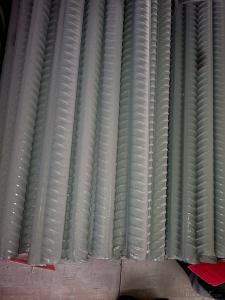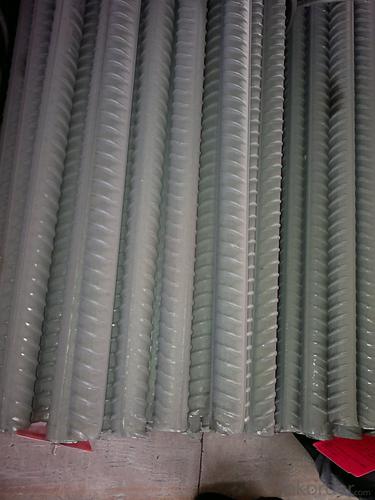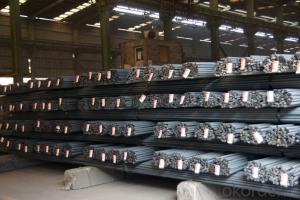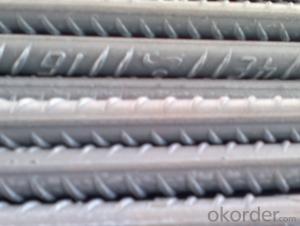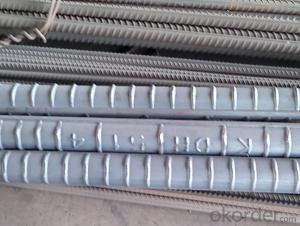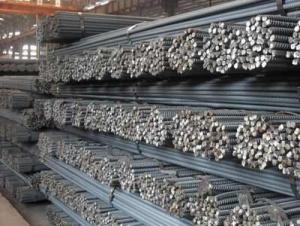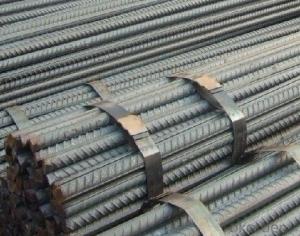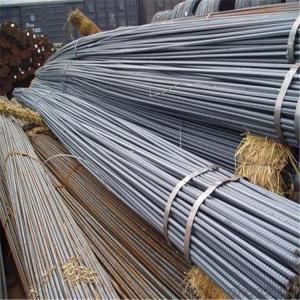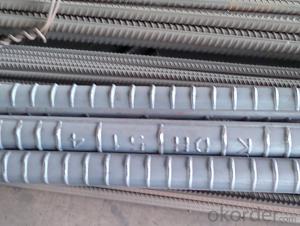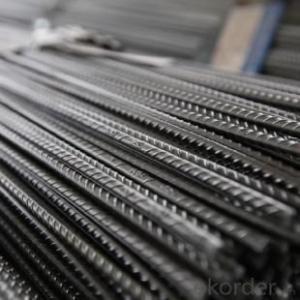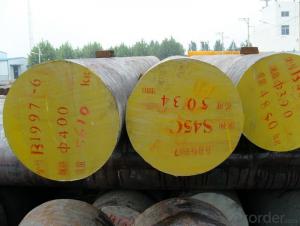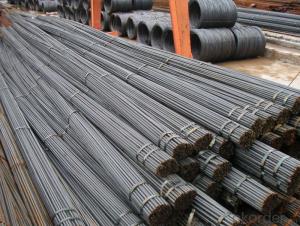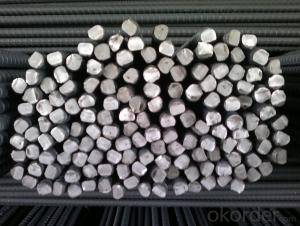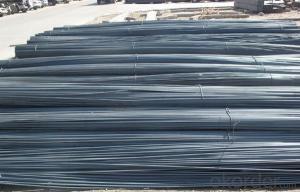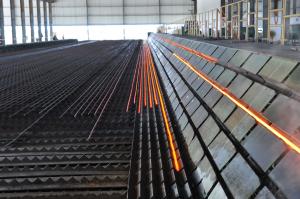GB Standard Deformed Steel Rebars HRB335, HRB400, HRB500
- Loading Port:
- Shanghai
- Payment Terms:
- TT or LC
- Min Order Qty:
- 25 m.t.
- Supply Capability:
- 200000 m.t./month
OKorder Service Pledge
OKorder Financial Service
You Might Also Like
Product Description:
OKorder is offering GB Standard Deformed Steel Rebars HRB335, HRB400, HRB500 at great prices with worldwide shipping. Our supplier is a world-class manufacturer of steel, with our products utilized the world over. OKorder annually supplies products to European, North American and Asian markets. We provide quotations within 24 hours of receiving an inquiry and guarantee competitive prices.
Product Applications:
GB Standard Deformed Steel Rebars HRB335, HRB400, HRB500 are ideal for structural applications and are widely used in the construction of buildings and bridges, and the manufacturing, petrochemical, and transportation industries. Deformed bar is widely used in buildings, bridges, roads and other engineering construction. Big to highways, railways, bridges, culverts, tunnels, public facilities such as flood control, dam, small to housing construction, beam, column, wall and the foundation of the plate, deformed bar is an integral structure material.
Product Advantages:
GB Standard Deformed Steel Rebars HRB335, HRB400, HRB500 are durable, strong, and resist corrosion.
Main Product Features:
· Premium quality
· Prompt delivery & seaworthy packing (30 days after receiving deposit)
· Corrosion resistance
· Can be recycled and reused
· Mill test certification
· Professional Service
· Competitive pricing
Specifications of GB Standard Deformed Steel Rebars HRB335, HRB400, HRB500
Standard | GB UK USA | HRB335 HRB400 HRB500 G460B, B500A, B500B,B500C GR40, GR60 | |
Diameter | 6mm,8mm,10mm,12mm,14mm,16mm,18mm,20mm, 22mm,25mm,28mm,32mm,36mm,40mm,50mm | ||
Length | 6M, 9M,12M or as required | ||
Payment term | TT or L/C | ||
Trade terms | FOB, CFR, CIF | ||
Application | Building, construction | ||
Each bundle weight | 2-3MT, or as required | ||
Type | Hot rolled steel rebar | ||
Brand name | OKORDER | ||
Theoretical weight and section area of each diameter as below for your information:
Diameter(mm) | Section area (mm²) | Mass(kg/m) | Weight of 12m (kg) | Pcs/ton |
6 | 28.27 | 0.222 | 2.664 | 375.38 |
8 | 50.27 | 0.395 | 4.74 | 210.97 |
10 | 78.54 | 0.617 | 7.404 | 135.06 |
12 | 113.1 | 0.888 | 10.656 | 93.84 |
14 | 153.9 | 1.21 | 14.52 | 68.87 |
16 | 201.1 | 1.58 | 18.96 | 52.74 |
18 | 254.5 | 2.00 | 24 | 41.67 |
20 | 314.2 | 2.47 | 29.64 | 33.74 |
22 | 380.1 | 2.98 | 35.76 | 27.96 |
25 | 490.9 | 3.85 | 46.2 | 21.65 |
28 | 615.8 | 4.83 | 57.96 | 17.25 |
32 | 804.2 | 6.31 | 75.72 | 13.21 |
36 | 1018 | 7.99 | 98.88 | 10.43 |
40 | 1257 | 9.87 | 118.44 | 8.44 |
50 | 1964 | 15.42 | 185.04 | 5.40 |
Deformed Steel Rebar in warehouse
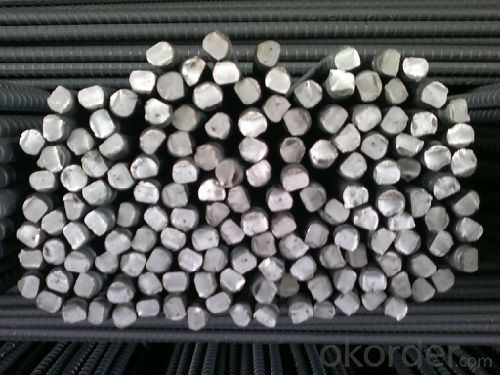
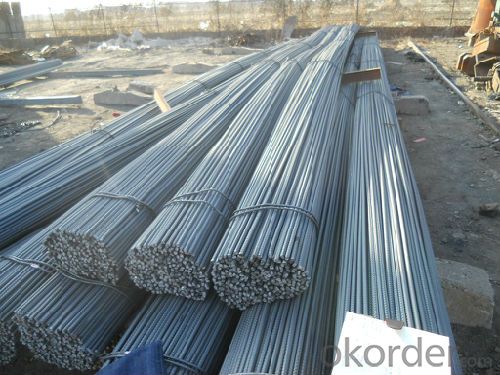
Packaging & Delivery of GB Standard Deformed Steel Rebars HRB335, HRB400, HRB500
Packaging Detail: products are packed in bundle and then shipped by container or bulk vessel, deformed bar is usually naked strapping delivery, when storing, please pay attention to moisture proof. The performance of rust will produce adverse effect.
Delivery Detail: within 45 days after received advanced payment or LC.
Label: to be specified by customer, generally, each bundle has 1-2 labels
Note:
1. Our products are produced according to national standard (GB), if not, supply according to national standards (GB) or agreement as customer required.
2. Other Grade and Standard Deformed Steel Bar we can supply:
Grade: GR40/GR60, G460B/B500A/B500B/B500C,BST500S
Standard: ASTM, BS, DIN
The Minimum Order Quantity of these products is high, and need to be confirmed.
3. We can not only supply Deformed Steel Bar; if you need anything about building materials, please contact us for further information.
4. Please send us your detail specifications when inquire. We will reply to you as soon as possible. We sincerely hope we can establish a long stable business relationship.
FAQ:
Q1: What is the normal tolerance of GB Standard Deformed Steel Rebars HRB335, HRB400, HRB500?
A2: Normally 3%-5%, but we can also produce the goods according to the customers' requests.
Q2: How do we guarantee the quality of GB Standard Deformed Steel Rebars HRB335, HRB400, HRB500?
A2: We have established an advanced quality management system which conducts strict quality tests at every step, from raw materials to the final product. At the same time, we provide extensive follow-up service assurances as required.
Q3: How soon can we receive the product after purchase?
A3: Within three days of placing an order, we will begin production. The specific shipping date is dependent upon international and government factors, but is typically 7 to 10 workdays.
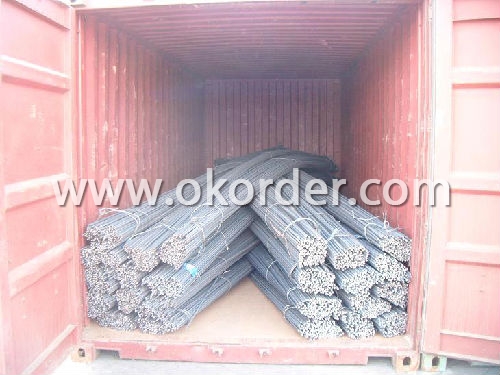
Deformed Steel Bar in factory
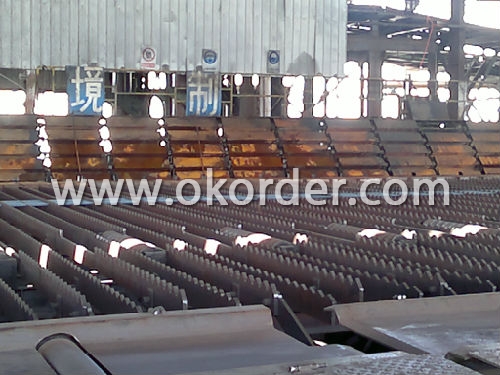
- Q: What is the role of steel rebars in increasing the load-carrying capacity of a structure?
- The load-carrying capacity of a structure is significantly improved by the utilization of steel rebars. These rebars are employed as reinforcement in concrete structures, enhancing their durability and strength. Typically composed of carbon steel, rebars are specifically designed to endure tension forces within the structure. When subjected to heavy loads or external forces, concrete tends to crack or deform. To combat these forces and inhibit the formation of cracks, steel rebars are strategically placed within the concrete. By distributing the load over a wider area, rebars contribute to the overall structural integrity of the system. The interlocking nature of rebars with the surrounding concrete also facilitates the transfer of stresses between the two materials. This ensures that the load is evenly spread throughout the structure, minimizing the risk of localized failures or collapses. Additionally, steel rebars provide the concrete with added tensile strength, which is typically lacking in tension. While concrete is strong under compression, it is relatively weak when exposed to tension. The introduction of rebars acts as a reinforcement framework, absorbing the tensile forces and preventing the concrete from cracking or failing under excessive loads. In conclusion, steel rebars play a crucial role in increasing the load-carrying capacity of a structure. They reinforce the structure, distribute loads, prevent cracks, enhance structural integrity, and counterbalance the weakness of concrete in tension. By incorporating rebars, engineers can design and construct safer and more resilient structures capable of withstanding greater loads and external forces.
- Q: How do steel rebars affect the ductility of reinforced concrete?
- Steel rebars greatly enhance the ductility of reinforced concrete by providing a strong and flexible reinforcement. The rebars absorb and distribute tensile forces, preventing cracks from forming and enhancing the overall strength and durability of the concrete structure.
- Q: Can steel rebars be used in corrosive environments?
- To ensure the longevity and structural integrity of steel rebars in corrosive environments, certain precautions must be taken. Corrosive environments, like those with high levels of moisture, saltwater, or chemical exposure, can accelerate the corrosion process of steel rebars and potentially cause structural damage. To mitigate this risk, there are various strategies that can be implemented. One common approach involves the use of corrosion-resistant reinforcing materials, such as stainless steel rebars or epoxy-coated rebars. These materials offer an additional layer of protection against corrosion and have proven to be effective even in highly corrosive environments. Another approach involves the utilization of corrosion inhibitors, which are chemicals that can be added to the concrete mix or directly applied to the steel surface. These inhibitors create a protective layer around the rebars, inhibiting corrosive agents from reaching the steel and slowing down the corrosion process. Furthermore, it is crucial to maintain an adequate thickness of concrete cover to protect the rebars from exposure to corrosive elements. Sufficient concrete cover acts as a barrier, preventing moisture and other corrosive agents from reaching the steel. Regular inspection and maintenance play a vital role in identifying early signs of corrosion. If corrosion is detected, appropriate measures should be taken to repair or replace the affected rebars, ensuring the structural integrity of the project. In conclusion, while steel rebars can be used in corrosive environments, it is essential to consider the specific conditions and employ the appropriate strategies to protect against corrosion. By using corrosion-resistant materials, applying inhibitors, maintaining proper concrete cover, and conducting regular inspections, the lifespan and performance of steel rebars in corrosive environments can be significantly enhanced.
- Q: What is the process of bending steel rebars into shapes other than straight bars?
- The process of bending steel rebars into shapes other than straight bars involves several steps and techniques. Firstly, the rebars need to be measured and marked to indicate the desired bending points and angles. This is usually done using a measuring tape, a square, and a marker. Next, the rebars are secured in a bending machine or a manual bending tool. The bending machine consists of two main components - a bending head and a bending table. The rebars are placed on the bending table, and the bending head is adjusted to the desired angle and position. Once the rebars are securely positioned, the bending process begins. For smaller rebars, manual tools such as a rebar bender or a rebar cutter can be used. These tools allow the worker to apply force and bend the steel rebar to the desired shape. For larger rebars or complex shapes, a hydraulic bending machine is often employed. This machine uses hydraulic pressure to bend the rebars, allowing for greater precision and control. The operator can adjust the angle and radius of the bend to achieve the desired shape. During the bending process, it is important to ensure that the rebars are not overstressed or damaged. Excessive bending can weaken the rebars and compromise their structural integrity. Therefore, it is crucial to follow the bending specifications and guidelines provided by engineers and construction standards. After the rebars have been bent to the desired shape, they are typically inspected for any defects or imperfections. This is done to ensure that the rebars meet the required standards and can be safely used in construction projects. In conclusion, the process of bending steel rebars into shapes other than straight bars involves measuring and marking, securing the rebars in a bending machine, applying force or hydraulic pressure to bend the rebars, and inspecting the final product for quality assurance. This process requires precision, skill, and adherence to safety guidelines to ensure the rebars can withstand the intended structural loads.
- Q: How are steel rebars protected against damage from seismic events?
- Steel rebars are protected against damage from seismic events through several methods. One common approach is by designing the structure with reinforced concrete walls or columns that act as a shield, absorbing and distributing the seismic forces. Additionally, engineers can use various techniques such as providing adequate cover for the rebars, using epoxy-coated rebars, and employing seismic detailing measures like confinement reinforcement to enhance their resistance to seismic forces. These strategies collectively help to mitigate damage and ensure the structural integrity of the steel rebars during seismic events.
- Q: Can steel rebars be used in sound barrier walls?
- Yes, steel rebars can be used in sound barrier walls. Steel rebars provide structural strength and stability to the walls, making them suitable for withstanding external forces and vibrations. Additionally, the steel rebars help in reinforcing the concrete used in the walls, enhancing their durability and longevity.
- Q: Is the finish steel 3 grade steel?
- The prestressed concrete thread reinforcing bar (also known as finishing thread reinforcing bar) is a kind of bar with big diameter, high strength and high dimension precision, which is rolled on the whole steel bar. The steel bar is screwed at any cross section with a connector with an internal thread to connect or screw on the threaded nut for anchoring. The fine rolled rebar is widely used in large water conservancy projects, continuous beams and large frame structures in industrial and civil buildings, highways, railways, large and medium span bridges, nuclear power plants and ground anchor projects. The utility model has the advantages of simple connection, simple anchoring, strong adhesive force, safe and reliable tension and tensioning, convenient construction, etc. the steel bar is saved, and the area and the weight of the component are reduced.
- Q: Can steel rebars be used in historical bridge restoration?
- Historical bridge restoration projects can benefit from the use of steel rebars. Over time, many historical bridges may have experienced deterioration or damage, and steel rebars can play a crucial role in providing strength and stability during the restoration process. Reinforced concrete structures often rely on steel rebars, which effectively reinforce the structural integrity of the bridge. Nevertheless, it is essential to carefully consider the historical bridge's aesthetics and guarantee that the incorporation of steel rebars does not compromise its historical value or appearance. Preservation guidelines and consultations with historical experts can prove invaluable in determining the suitable application of steel rebars in historical bridge restoration endeavors.
- Q: Can steel rebars be used in structures subjected to chemical exposure?
- Steel rebars can be used in structures subjected to chemical exposure, but their suitability depends on the specific type and concentration of chemicals involved. In general, stainless steel rebars or epoxy-coated rebars are preferred for such applications as they provide better resistance to corrosion and chemical attack compared to plain carbon steel rebars. However, it is important to conduct a thorough evaluation of the chemical environment and consult with experts to determine the most appropriate rebar material for the specific structure and its intended use.
- Q: Are steel rebars susceptible to magnetic fields?
- Steel rebars can be affected by magnetic fields. They are made from a ferromagnetic material, which means they can be magnetized and are attracted to magnets. This is because iron is present in the composition of steel. When steel is exposed to a magnetic field, its atoms align with the field, resulting in magnetization. However, it is worth mentioning that a strong magnetic field is usually needed to magnetize steel rebars, requiring a powerful magnet. In regular circumstances, the magnetic fields encountered are not powerful enough to considerably impact the behavior or properties of steel rebars.
Send your message to us
GB Standard Deformed Steel Rebars HRB335, HRB400, HRB500
- Loading Port:
- Shanghai
- Payment Terms:
- TT or LC
- Min Order Qty:
- 25 m.t.
- Supply Capability:
- 200000 m.t./month
OKorder Service Pledge
OKorder Financial Service
Similar products
Hot products
Hot Searches
Related keywords
